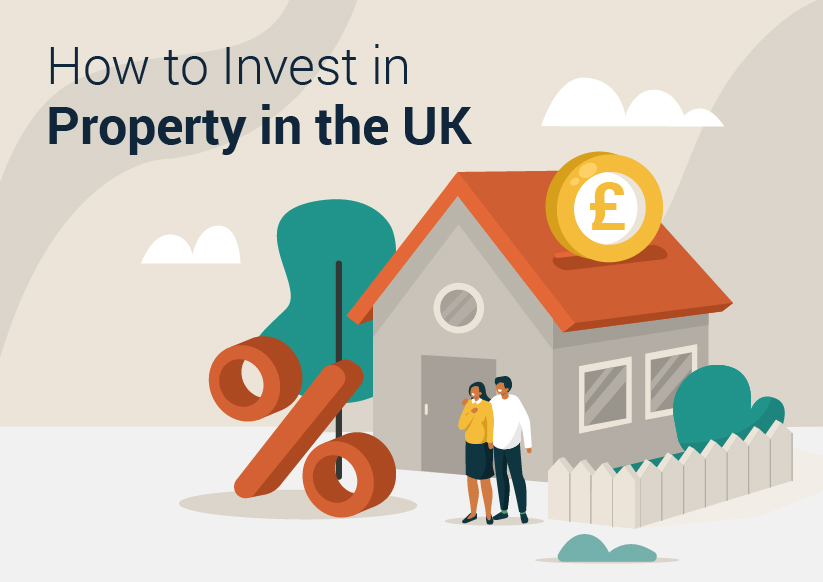How to Invest in Property in the UK

For those looking to invest in property, the UK is continually one of the world’s most popular investment markets. The UK house prices are predicted to rise by 21.1% by 2025. While property investment UK-wide is thriving, certain areas of the country, in particular, can present savvy investors with great returns. With many opportunities available, high rental yields and house prices on the rise, investing in the UK property market offers bright prospects.
The UK offers a range of different property types, from city centre apartments to rural cottages and commercial premises. Investors can choose the type of property that best suits their needs and budget. In addition, there are numerous opportunities available for all types of investors.
So how can you invest in property in the UK? What are the opportunities available? Is investing in the UK a good idea? If you’re looking for information on getting started with property investment in the UK, read on to have your questions answered.
How Much Money do you Need to Invest in Property in the UK?
Before diving into more detail on how to invest in property in the UK, it’s essential that investors have full visibility on the costs involved. While the exact amount of money required to make an investment in UK property will vary based on the type of property, its location and how you intend to fund it (e.g. paying in full vs mortgage), there are some other expenses that should be considered.
For any property, a deposit of between 5-40% of the total property cost will apply. If you’re not a resident in the UK, it may be trickier to get a mortgage or loan, as many lenders will not approve non-UK residents. Non-UK residents will also need to pay an additional 2% Stamp Duty, on top of the normal charge, unless the property value is under £300,000 and they are first-time buyers in the UK.
If you invest in a buy-to-let property in the UK that you plan on letting out to tenants, you’ll need to pay the appropriate tax on any rental income you generate. At the same time, investors in UK property will need to pay capital gains tax on any increase in value of the property when they come to sell it.
Finally, you’ll also need to consider the ongoing costs associated with managing a property, such as maintenance, repairs and any professional fees associated with renting out the property.

How do you Start Investing in Property in the UK?
Buy-to-Let
When investing in a buy-to-let property, the first thing to consider is the type of property you want to focus on.
Residential buy-to-let properties are the most popular property investment strategy in the UK. The key benefit for investors is that these properties generate two types of returns – monthly rental income and profit generated from capital gains upon sale of the property. If investing in a property with strong rental yields, the rental income generated can be used to cover mortgage repayments and ongoing maintenance and repairs. But investors should be aware that a buy-to-let property may not be for everyone. For example, investors need to be sure not to invest in an area that is low performing in terms of rental returns and capital growth, which is why it’s essential to fully research and investigate the best performing areas of the UK.
It’s also important to consider new developments such as shopping centres or transport links that can boost the value of your buy-to-let property and help increase rental yields. Therefore, researching the local area and any upcoming developments is essential in order to make an informed decision when investing in a buy-to-let property.
Buy-to-Sell
Buy-to-sell is another popular investment strategy in the UK. This is a good option for investors looking to receive a cash lump sum through a short-term investment. Most buy-to-sell investments involve flipping the property, i.e., undertaking repairs and improvements to generate a return. Our friends from Springmove can help you to sell your house fast, and if you want to avoid a stressful move, this is the check list that can help you!
There are high potential returns if investors choose the right property, and with no buy-to-let maintenance costs, or effort needed to find tenants and undertake the ongoing responsibilities of being a landlord, flipping a property can be a good strategy for many investors. On the downside, flipping a property can require a lot of work and knowledge to pick a property that has the potential to increase in value and get the right repairs done to boost its sale value.
It is, therefore, important to do your research and due diligence before taking on a buy-to-sell investment. Additionally, you need to factor in the costs of repairs and improvements and ensure that you will be able to sell the property for more than you paid for it.
Student Property Investment
Investing in student property is another popular option for investors – whether this is purpose-built student accommodation or a house of multiple occupancies (HMO). With a growing student market in the UK and increased demand for student properties, this type of investment can be lucrative – not to mention the fact that student rental properties can generate up to 20% more than other rental demographics.
Investing in student property does come with some drawbacks. For example, you’re limited to one type of tenant – university students – and the property may be vacant during the summer holidays. Student properties tend to come with more upfront costs, wear and tear and renovation cost too. If you’re wondering whether student property is a good investment, find out more in our student property investment UK guide.
Also, student properties can also benefit from long-term capital growth due to their popularity with investors and the increased demand for student housing in the UK.
When it comes to investing in a property in the UK, investors need to explore the different options to work out which investment strategy is right for them.

Is Property a Good Investment in the UK?
Considering the UK housing market as it currently stands, the opportunities available and the potential returns, investing in a buy-to-let property is one of the best investment strategies on offer because it gives investors rental income along with capital growth returns.
Investors should look for areas with high rental yields, which means that the property can more or less pay for itself, covering the mortgage and upkeep. A good rental yield in the UK is around 5% and some areas can deliver 8% or higher. Investors should also look at the potential for a property to grow in value. In the coming years, the North West of England can offer potentially lucrative returns, with predictions that it will see significant growth of 28.8% by 2025.
As a landlord, be sure to understand your tenant market and what they look for. Young professionals are increasingly seeking stylish, modern design, amenities in close proximity and convenient transport links. Students often look to share and seek out larger accommodation of 3-5 bedrooms with ample kitchen and living areas to enhance communal living. Finally, with an uptick in the number of us working from home due to the Coronavirus pandemic, renters are looking for more outdoor space and spare rooms that can be a home office as well. Being aware of what tenants desire is key to making your property a good investment in the UK.
Projects for UK Property Investors to Consider
After understanding how to invest in property in the UK, you might want to begin to look at the type of developments and properties on offer. The following developments offer investors strong prospects:
1. Sky Gardens, Leeds
In the next few years, Leeds should become the UK’s number 1 city for capital growth. With house prices predicted to rise by 28% by 2024. With strong job prospects, the city is home to a large number of young professionals that offer a good market for landlords. Sky Gardens is a new development that includes a residential tower and the refurbishment of a grade 2 listed building, located in the much-sought-after Southbank.
Find out more about how to invest in a property in the UK in Skygarden Leeds
2. The Wells, Nottingham
The Wells should be a high-growth real estate development in one of Nottingham’s most prestigious locations. Nottingham is already a popular place for property investors in the UK thanks to strong performing property price growth – the top UK city in the past 12 months – and 25.5% growth forecasts over the next 5 years. Located close to the city centre, The Wells is tipped to offer rental yields of 7.5%, particularly because demand for new housing is outpacing supply.
Find out more about how to invest in property in the UK in The Wells Nottingham
3. The Printworks, Bradford
Benefitting from 8% yields and with properties on offer from as little as £120,000, Bradford’s The Printworks is a development investors won’t want to miss. Bradford is one of the fastest-growing cities in the UK today. The region should see price increases of 28% in the next 4 years alone. Bradford was recently named in the top 10 best buy-to-let areas in the UK. And some properties can offer between 8 – 10% rental yields.
Find out more about how to invest in a property in the UK in The Printworks Bradford
____________________________________________________________________________________________
Conclusion
If you’re wondering how to invest in property in the UK, we hope this guide has given you some of the key information you need to get started. Before making any investment, understand the costs involved. Also decide on the type of property you want to invest in and be sure to take a look at whether the area presents appealing house price growth in the future. For the most up to date advice, get in touch with one of our advisors.




